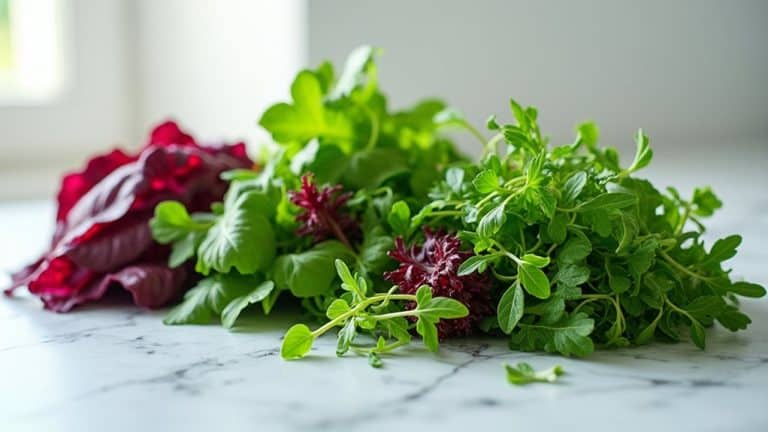Pitfalls of Planting Seeds Too Early
When you plant seeds too early, you might be setting yourself up for a range of issues that can derail your gardening efforts. Frost damage can easily ruin fragile seedlings, while cooler soil temperatures can stunt their growth. Plus, early planting often invites diseases and pests, which thrive in those moist conditions. Understanding these risks is vital, but there's more to evaluate if you want to achieve the best results. What strategies can you employ to avoid these pitfalls and guarantee your garden flourishes?
TLDR
- Early planting risks frost damage, causing ice formation in seedlings, leading to cell rupture and dehydration.
- Cooler soil temperatures can stunt growth, resulting in leggy plants and increased vulnerability to late frosts.
- Premature planting can trigger diseases like Pythium and Phytophthora due to cool, wet conditions, jeopardizing seedling health.
- Early sowing elevates pest risks, exposing seedlings to infestations from aphids and root-destroying maggots.
- Fluctuating soil moisture levels from early planting can hinder seed hydration and lead to rootbound conditions, affecting overall growth.
Risks of Frost Damage
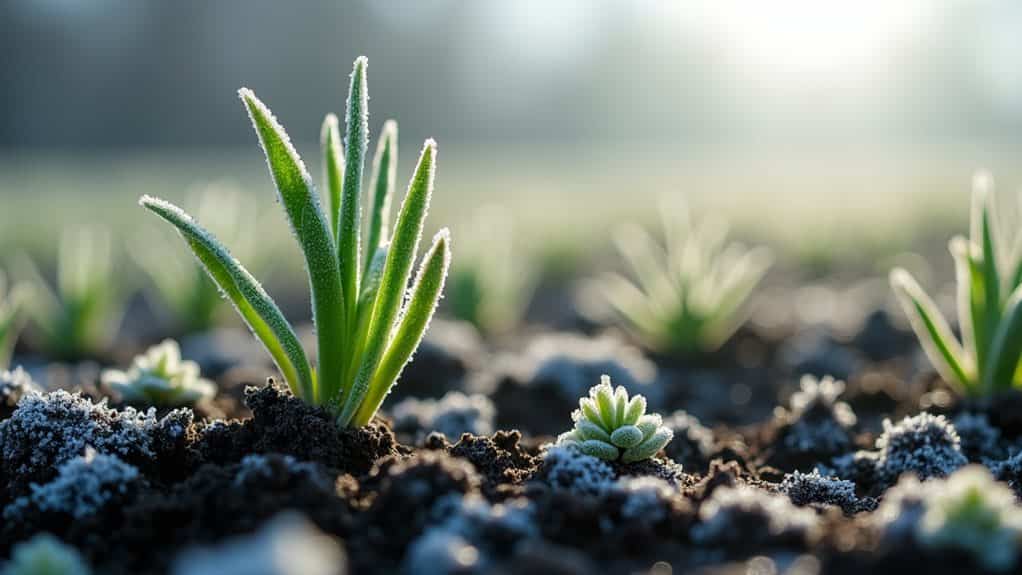
When you're planting seeds, one of the biggest risks you face is frost damage. Imagine your tiny seedlings freezing like popsicles! Ice forms inside them, causing cell rupture and dehydration.
If it's super dry at night, your plants might dodge frost, but once dew hits, frost crystals can take over. It's like a winter party your seedlings didn't RSVP to—definitely not fun! Consistent warm temperatures are crucial for optimum growth, and planting too early can lead to disastrous effects if frost strikes. Additionally, the acidic soil conditions under certain trees can further complicate growing seedlings if they are not suited for such environments.
Effects on Plant Growth
Planting seeds too early can seriously affect plant growth. You might think your plants are ready to take off, but cooler temps can stunt their growth, leaving you with sad, leggy seedlings. Starting seeds too early increases risks of late frost damage, which can further jeopardize your plants' health. Imagine waiting weeks for soybeans to show up! Plus, if they get rootbound, they'll feel cramped and unhappy. Additionally, soil moisture levels can fluctuate, making it essential to monitor hydration once your seeds do sprout.
Disease Vulnerability
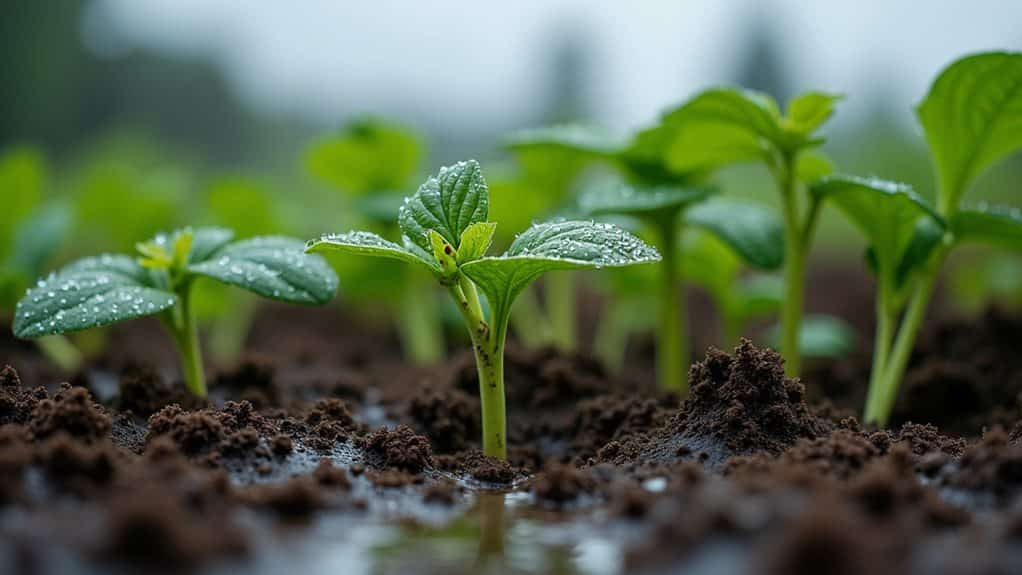
When you're planting seeds, have you ever thought about how vulnerable they're to diseases?
It's like sending your little green buddies into a swamp of germs—cool, wet conditions can slow down germination and invite all sorts of pesky pathogens to crash the party. This year, the increased frequency of soilborne pathogens due to cool spring temperatures has made it even more crucial to monitor for potential threats. Ensuring your soil is well-drained is vital for preventing potato rot and promoting healthy growth.
Increased Disease Exposure
How can cool and wet soil conditions lead to increased disease exposure for your crops?
Well, these soggy conditions are like a five-star resort for nasty pathogens like Pythium and Phytophthora! They thrive, causing mushy roots and stunted growth. If your seedlings get infected, they mightn't even make it out of the ground. Yikes! Additionally, cool, wet conditions can slow down growth, making plants even more vulnerable to infection.
Slow Germination Risks
Cool, wet soil conditions not only increase disease exposure but also greatly slow germination processes. When seeds sit in chilly, soggy soil, they waste energy waiting to sprout, which is like waiting for your favorite song to play while stuck in a long line. Plus, those poor seedlings become easy targets for diseases, making it essential to plant at the right time! Furthermore, early germination can create opportunities in low-competition periods, allowing certain species to establish themselves more effectively before competitors emerge.
Pest Interaction Challenges
Planting seeds comes with its own set of challenges, especially when it comes to disease vulnerability.
If you plant in cool, wet soils, you're inviting pesky pathogens like Pythium and Phytophthora to crash the party! They love those conditions, causing issues like root rot. Implementing cultural control practices, such as ensuring proper soil drainage and avoiding overwatering, can significantly reduce the likelihood of these diseases taking hold.
Pest Infestation Concerns
In early spring, the risk of pest infestations in wheat crops greatly increases.
You wouldn't want those sneaky aphids munching away, spreading nasty viruses like barley yellow dwarf, would you?
Plus, early planting invites the dreaded Hessian flies and root-destroying maggots! Delayed planting helps mitigate these pest issues and can be a crucial strategy for protecting your crops. Additionally, keeping your lawn well-maintained can reduce breeding grounds for flies and other pests that may threaten your plants.
So, consider using treated seeds or resistant varieties—it's like giving your plants superhero powers against pests!
Trust me, it's worth it!
Indoor Light Limitations
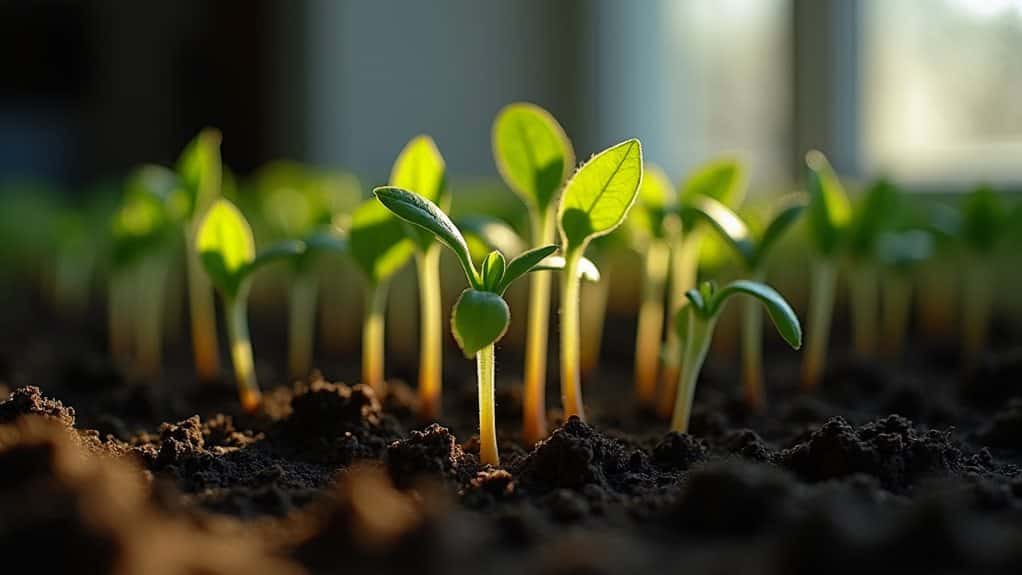
While you've taken precautions against pests in your outdoor planting, the challenges don't stop there—especially when starting seeds indoors.
It's a common mistake to rely on that sunny window, but trust me, those poor seedlings will just stretch and flop like they're auditioning for a circus! Instead, invest in grow lights; your plants will thank you with strong, sturdy growth and fewer tantrums! The ideal temperature for most seeds is around 75°F (24°C), which can be difficult to achieve with just natural light from a window. Additionally, understanding the importance of essential nutrients will help ensure your seedlings have the best start possible.
Space Requirements for Seedlings
Understanding space requirements for seedlings is essential to their success. If you cram them too close, they'll get all tangled up like a bad hair day! Small seeds need about 3 inches apart, while larger ones demand more room. Give them space to breathe, or you'll be stuck repotting constantly. Trust me, your seedlings will thrive and thank you with bountiful growth! Ensuring optimum germination environment is crucial as it helps prevent seedlings from becoming weak and leggy.
Resource Management Challenges
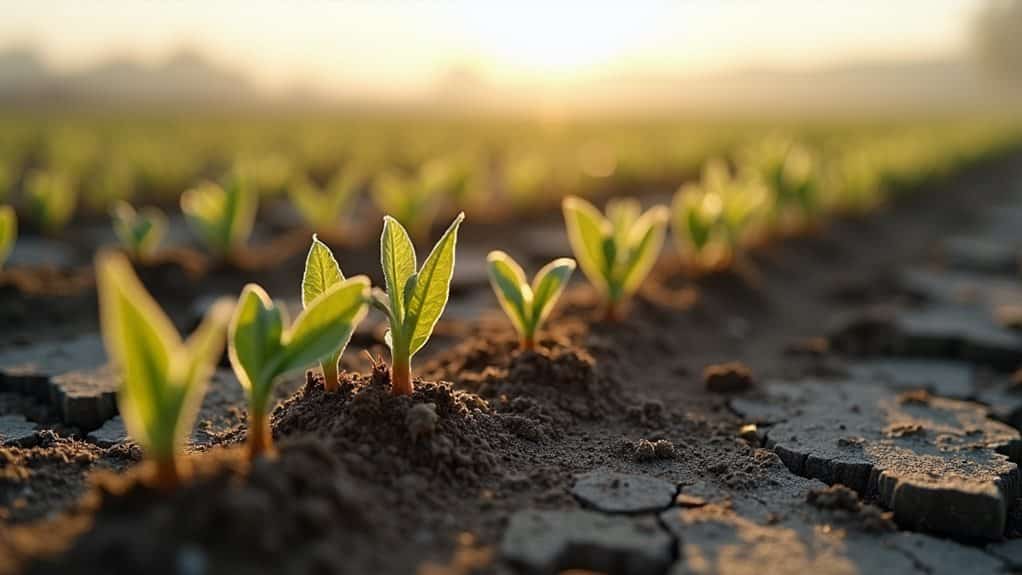
Resource management challenges can greatly impact the success of seed production and distribution. If you can't predict demand accurately, you might end up with tons of seeds nobody wants or, worse, not enough to meet farmer needs. Plus, managing your inventory is like juggling flaming torches—too much can spoil, and too little leaves everyone in a pickle. Additionally, maintaining seed quality during fluctuations in demand is crucial to ensure that the seeds remain viable and effective for planting.
Timing for Optimal Growth
Timing is everything when it comes to planting seeds for ideal growth.
You've gotta know your last frost date, right? For cold crops, start 10 weeks ahead, while summer favorites like tomatoes need just 7 weeks. Good indoor environments are crucial for seed starting success, helping young plants thrive before they go outside.
Check those seed packets, and don't forget—warm crops thrive at around 70°F!
Get it right, and your garden will be bursting with life!
Consequences of Premature Bolting
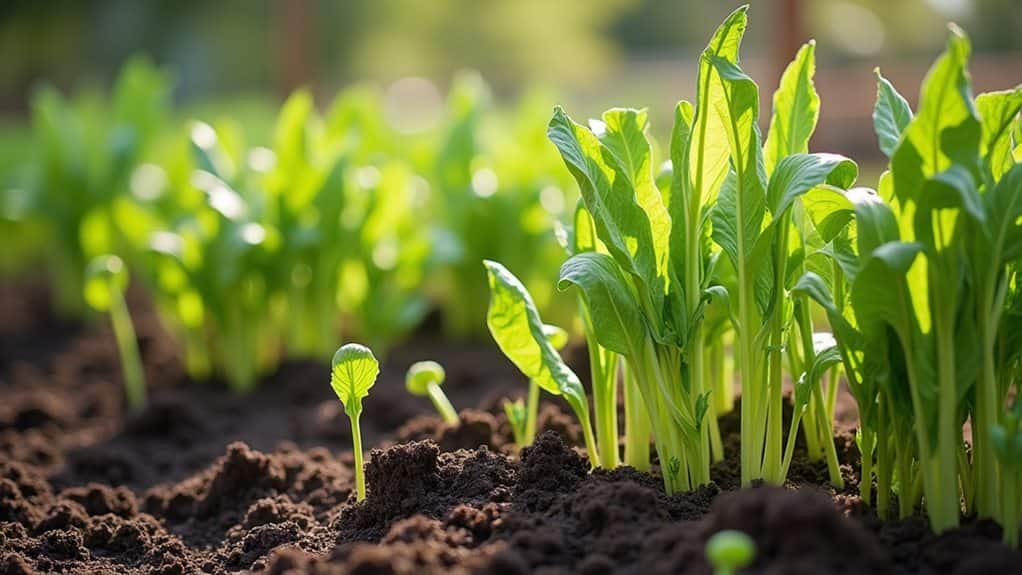
Planting seeds at the right time is just the first step; the consequences of premature bolting can have a significant impact on your garden's success.
When plants bolt too soon, they shift energy away from producing delicious veggies to making seeds. This leads to tough, bitter greens and a sad harvest. Factors such as temperature fluctuations can trigger this bolting process, making it crucial to monitor environmental conditions closely.
Soil Temperature Considerations
When you're getting ready to plant those seeds, you really need to pay attention to soil temperature—it's like giving your plants a cozy blanket or a chilly wake-up call!
Did you know that cool soil can slow down germination, leaving your precious seeds vulnerable to all sorts of nasties, while warm crops that get planted too early might just throw a tantrum and refuse to grow? The ideal soil temperature for many crops, such as 85°F for germination, can significantly enhance seedling vigor and overall growth.
Optimal Soil Temperature Range
Understanding the ideal soil temperature range for your crops can greatly enhance your gardening success.
Imagine planting beans at a cozy 70°F—perfect!
But if it's too cold or hot, your seeds might just sulk and refuse to sprout.
So, keep an eye on those temperatures, and your garden will thrive like a champ! Proper soil temperature contributes to overall crop yield and quality, so trust me, it's worth it!
Effects of Cool Soil
Cool soil can throw a wrench in your gardening plans, especially when it comes to germination and seedling health.
If the soil's below 50°F, your seeds might just chill out instead of growing! Cold temperatures can cause seeds to rot or suffer from diseases, leading to sad, weak plants. Soil temperature below this threshold not only inhibits growth but also increases the likelihood of pest and pathogen attacks, further jeopardizing seedling health.
Timing for Warm Crops
Timing is essential for planting warm-season crops, as soil temperature directly impacts germination and healthy growth.
For tomatoes and cucumbers, you need that soil at least 60°F. Aim for 70°F to 75°F for ideal growth. Soil temperature is key to successful planting, as it influences the overall health and vigor of your crops.
If you plant too early, your crops might get stunted or even wilt. So, check the soil, and be patient—good things come to those who wait!
Strategies for Successful Sowing
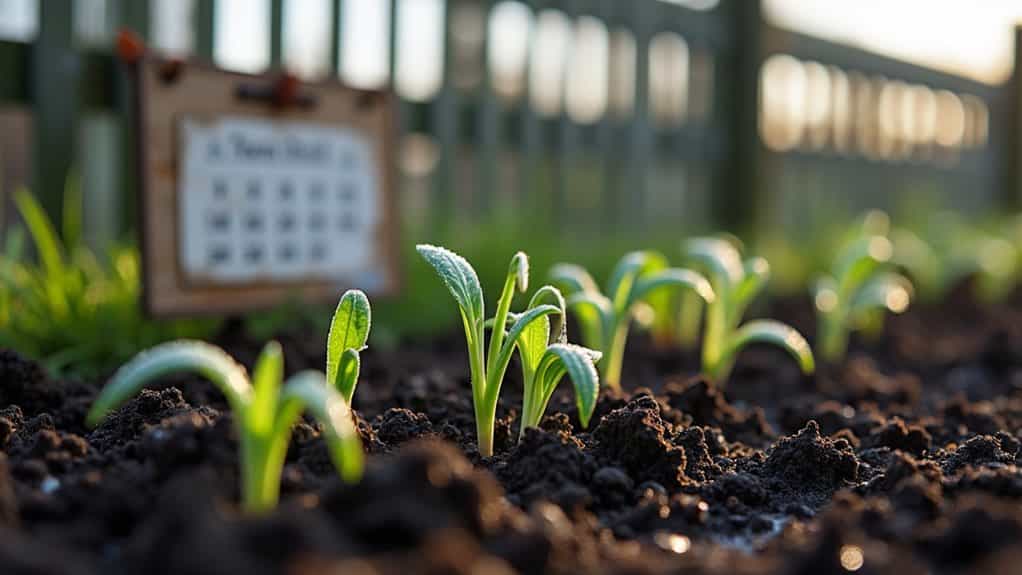
Successfully sowing seeds requires careful attention to several key strategies.
First, prep that soil—make it loose and smooth for happy seeds! Incorporating compost can help revitalize the soil and ensure optimal seed contact.
Next, plant at the right depth and keep 'em moist, but not swimming! And don't forget to check the temps; warm seeds are happy seeds!
Just remember: no premature planting—it's like trying to bake cookies before the oven's ready!
And Finally
So, remember, planting seeds too early might sound tempting, but you could end up with sad, frost-bitten plants or a garden overrun by pests! Instead, take your time, check those soil temps, and wait for the right moment. Trust me, your plants will thank you by growing strong and healthy, just like a well-rested camper ready to tackle a hiking trail! So, let's keep our planting plans smart and our gardens thriving! Happy gardening!




